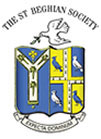|
 |
The Old St Beghian | |
| July 2016 | |||
Alan Rice (FS 49-54) has contributed the following piece:
Contact Sports.
“In early September 1949, about a week before I was due to come to St Bees, my sport of that day was ‘conkers’. Most trees had been stripped and the last available supplies were high in a tree in a disused local cemetery. The normal technique of throwing up a stick to dislodge the conkers was not working and so I decided to climb and shake the branch. I completely failed to carry out what in modern times would be called a risk assessment.
Having climbed and clambered to the branch, I held on to a higher branch and jumped on the laden branch to shake down the selected bunch. This technique was flawed: I think that, due to the dry weather, the supporting branch was prone to fracture. It did. I fell something between fifteen and twenty feet making a very dynamic contact with the ground. However, I was lucky to a certain extent: I narrowly missed falling onto the cruciform headstone of a grave.The injury was a fractured fibula, which resulted in a foot and lower leg plaster cast. I came to school thus encumbered and my introduction to rugby was set back by four weeks.
On the date for the cast to be removed, I was escorted to the school doctor’s surgery, in Whitehaven, by the Foundation matron, Sheila Appleyard. After removing the plaster the doctor said ‘I’ll just check for any adhesions’. He held my lower leg and fiercely jerked (the only appropriate phrase I can think of) my foot up and down to the limit, and possibly beyond, the normal deflection. The pain was intense but fortunately of short duration. As a parting shot he opined that the hospital should have strapped the fracture and that it would have healed quicker and without the need to check for adhesions.
My second appreciation of contact sports came when playing my first game for the First XV - as full-back. I believe it was at the end of the Easter Term in 1953. We were playing Whitehaven RUFC away. As a ‘men’s team’, they had some very capable and fast backs, in particular the left wing, by name Watchorn. He was fast and ran with high lifting knees. Inevitably I came into contact with him in a low head-on tackle. He was stopped in his tracks, which was the whole object - one of the serious things we trained for with Mr Carter and Mr Brown. However, I was concussed and though I managed to play on, after a short stoppage, the rest of the game seemed somewhat blurred and unreal.
Recovering the next day I found that I was deaf in my left ear and I sought the ministrations of Sheila Appleyard. It was a burst ear-drum and the school doctor had to be consulted. He prescribed that the ear be treated by pouring in, daily, a measure of surgical alcohol. Unless you have undergone this procedure, it is hard to imagine the pain involved. However, it did gradually heal the ear-drum and all seemed well again. About one year later, I was in the process of a medical for the Royal Air Force with the career ambition to fly: I was very quickly ruled out on the basis that a burst ear drum, even though it had healed, could only be regarded a source of weakness and was not acceptable for flying duties.
Since a flying career with the RAF had been my first choice, I was greatly disappointed. On top of the disappointment, I made the mistake of turning down an offer of admission to the RAF programme for Engineering Officers. In those days it was run in conjunction with study for a degree at Cambridge and officer training at Cranwell.
It was a further fourteen years before I gained a private pilot’s licence.”
Home
The St Beghian Society
St Bees School,
St Bees, Cumbria, CA27 0DS.
Tel: (01946) 828093 Email: osb@stbeesschool.co.uk
Web: www.st-beghian-society.co.uk
![]()